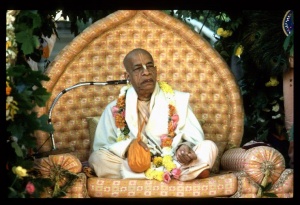SB 1.4.4: Difference between revisions
m (1 revision(s)) |
No edit summary |
||
| Line 1: | Line 1: | ||
{{info | {{info | ||
|speaker= | |speaker=Śaunaka Ṛṣi | ||
|listener= | |listener=Sūta Gosvāmī and the Sages | ||
}} | }} | ||
[[Category:Srimad-Bhagavatam - Canto 01 Chapter 04|S04]] | |||
[[Category:Bhagavatam Verses Spoken by Saunaka Rsi - Vanisource|010404]] | |||
<div style="float:left">'''[[Srimad-Bhagavatam]] - [[SB 1|First Canto]] - [[SB 1.4: The Appearance of Sri Narada|Chapter 4: The Appearance of Śrī Nārada]]'''</div> | |||
<div style="float:right">[[File:Go-previous.png|link=SB 1.4.3]] '''[[SB 1.4.3]] - [[SB 1.4.5]]''' [[File:Go-next.png|link=SB 1.4.5]]</div> | |||
{{CompareVersions|SB|1.4.4|SB 1962|SB 1972-77}} | |||
{{RandomImage}} | |||
==== TEXT 4 ==== | ==== TEXT 4 ==== | ||
<div | <div class="verse"> | ||
tasya putro mahā-yogī | :tasya putro mahā-yogī | ||
sama-dṛṅ nirvikalpakaḥ | :sama-dṛṅ nirvikalpakaḥ | ||
ekānta-matir unnidro | :ekānta-matir unnidro | ||
gūḍho mūḍha iveyate | :gūḍho mūḍha iveyate | ||
</div> | </div> | ||
| Line 17: | Line 23: | ||
==== SYNONYMS ==== | ==== SYNONYMS ==== | ||
<div | <div class="synonyms"> | ||
''tasya''—his; ''putraḥ''—son; ''mahā-yogī''—a great devotee; ''sama-dṛk''—equibalanced; ''nirvikalpakaḥ''—absolute monist; ''ekānta-matiḥ''—fixed in monism or oneness of mind; ''unnidraḥ''—surpassed nescience; ''gūḍhaḥ''—not exposed; ''mūḍhaḥ''—stunted; ''iva''—like; ''īyate''—appears like. | |||
</div> | </div> | ||
| Line 24: | Line 30: | ||
==== TRANSLATION ==== | ==== TRANSLATION ==== | ||
<div | <div class="translation"> | ||
His [Vyāsadeva's] son was a great devotee, an equibalanced monist, whose mind was always concentrated in monism. He was transcendental to mundane activities, but being unexposed, he appeared like an ignorant person. | His [Vyāsadeva's] son was a great devotee, an equibalanced monist, whose mind was always concentrated in monism. He was transcendental to mundane activities, but being unexposed, he appeared like an ignorant person. | ||
</div> | </div> | ||
| Line 31: | Line 37: | ||
==== PURPORT ==== | ==== PURPORT ==== | ||
<div | <div class="purport"> | ||
Śrīla Śukadeva Gosvāmī was a liberated soul, and thus he remained always alert not to be trapped by the illusory energy. In the Bhagavad-gītā this alertness is very lucidly explained. The liberated soul and the conditioned soul have different engagements. The liberated soul is always engaged in the progressive path of spiritual attainment, which is something like a dream for the conditioned soul. The conditioned soul cannot imagine the actual engagements of the liberated soul. While the conditioned soul thus dreams about spiritual engagements, the liberated soul is awake. Similarly, the engagement of a conditioned soul appears to be a dream for the liberated soul. A conditioned soul and a liberated soul may apparently be on the same platform, but factually they are differently engaged, and their attention is always alert, either in sense enjoyment or in self-realization. The conditioned soul is absorbed in matter, whereas the liberated soul is completely indifferent to matter. This indifference is explained as follows. | Śrīla Śukadeva Gosvāmī was a liberated soul, and thus he remained always alert not to be trapped by the illusory energy. In the ''Bhagavad-gītā'' this alertness is very lucidly explained. The liberated soul and the conditioned soul have different engagements. The liberated soul is always engaged in the progressive path of spiritual attainment, which is something like a dream for the conditioned soul. The conditioned soul cannot imagine the actual engagements of the liberated soul. While the conditioned soul thus dreams about spiritual engagements, the liberated soul is awake. Similarly, the engagement of a conditioned soul appears to be a dream for the liberated soul. A conditioned soul and a liberated soul may apparently be on the same platform, but factually they are differently engaged, and their attention is always alert, either in sense enjoyment or in self-realization. The conditioned soul is absorbed in matter, whereas the liberated soul is completely indifferent to matter. This indifference is explained as follows. | ||
</div> | </div> | ||
__NOTOC__ | |||
<div style="float:right; clear:both;">[[File:Go-previous.png|link=SB 1.4.3]] '''[[SB 1.4.3]] - [[SB 1.4.5]]''' [[File:Go-next.png|link=SB 1.4.5]]</div> | |||
__NOTOC__ | |||
__NOEDITSECTION__ | |||
Revision as of 14:36, 29 April 2021

A.C. Bhaktivedanta Swami Prabhupada
TEXT 4
- tasya putro mahā-yogī
- sama-dṛṅ nirvikalpakaḥ
- ekānta-matir unnidro
- gūḍho mūḍha iveyate
SYNONYMS
tasya—his; putraḥ—son; mahā-yogī—a great devotee; sama-dṛk—equibalanced; nirvikalpakaḥ—absolute monist; ekānta-matiḥ—fixed in monism or oneness of mind; unnidraḥ—surpassed nescience; gūḍhaḥ—not exposed; mūḍhaḥ—stunted; iva—like; īyate—appears like.
TRANSLATION
His [Vyāsadeva's] son was a great devotee, an equibalanced monist, whose mind was always concentrated in monism. He was transcendental to mundane activities, but being unexposed, he appeared like an ignorant person.
PURPORT
Śrīla Śukadeva Gosvāmī was a liberated soul, and thus he remained always alert not to be trapped by the illusory energy. In the Bhagavad-gītā this alertness is very lucidly explained. The liberated soul and the conditioned soul have different engagements. The liberated soul is always engaged in the progressive path of spiritual attainment, which is something like a dream for the conditioned soul. The conditioned soul cannot imagine the actual engagements of the liberated soul. While the conditioned soul thus dreams about spiritual engagements, the liberated soul is awake. Similarly, the engagement of a conditioned soul appears to be a dream for the liberated soul. A conditioned soul and a liberated soul may apparently be on the same platform, but factually they are differently engaged, and their attention is always alert, either in sense enjoyment or in self-realization. The conditioned soul is absorbed in matter, whereas the liberated soul is completely indifferent to matter. This indifference is explained as follows.